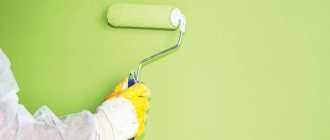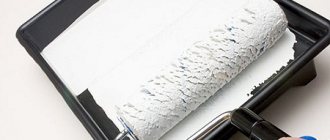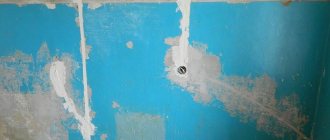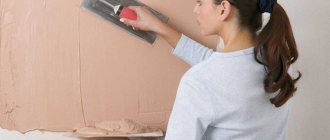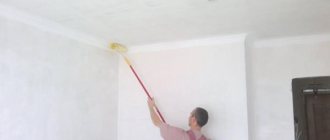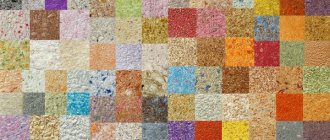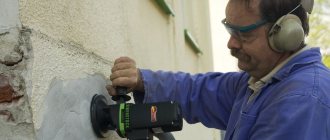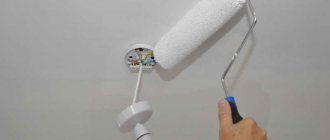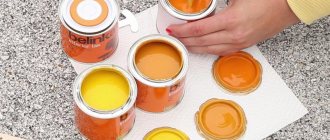Repair requires a lot of effort and time to make a high-quality update of the interior of an apartment or house. For this reason, many property owners want to reduce some of the work, especially when it comes to carrying out the finishing stage with their own hands. If the surface of the walls was previously painted, then beginners wonder: is it possible to apply paint over paint? The consequences of this decision, and in what cases this is permissible, will be discussed below.
Can paint be applied to paint?
Professionals do not recommend painting over another coloring material. For them, the stage of removing the old finish is mandatory. The reason is the danger of peeling off the previous coating, and if you apply a new layer on it, it will suffer along with the old one.
Having painted a light color on top, there is a high probability of noticing dark spots appearing through it. All flaws in the previous finish will be noticeable. In addition, not all paints and varnishes are compatible; their components may not fit each other, the layer will not apply well, and the degree of adhesion will be low.
Applying one layer to another is permissible only if the first one is in good condition, if it is perfect and lies securely on the surface. It is advisable to use similar paints and varnishes; it is optimal to paint the wall with the same types of paints.
For professionals, the stage of removing the old finish is mandatory.
Table of correct combinations
When repainting old coatings, you need to consider the combination of different painting materials with each other. When applying a new base to an old one, instead of the expected decorative and protective effect, you can ruin the product. With the right combination of types of paintwork materials, the paint will lay down in an even layer and will adhere tightly.
The table below contains information about the compatibility of certain paints and varnishes with each other:
| Type of paints and varnishes | Type of old coating | ||||||||||||
| AK | AC | AU | VL | GF | ML | MCH | PF | UR | FL | HV | EP | ||
| Alkyd acrylic paints AC | AC | + | + | — | + | — | — | + | + | — | + | + | + |
| Alkyd-urethane AC | AU | — | — | + | + | + | — | — | — | — | + | — | + |
| Glypthal GF | GF | + | — | — | + | + | — | — | + | — | + | — | + |
| Organosilicon CO | KO | + | — | — | — | — | — | — | — | — | — | — | — |
| Oil MA | MA | — | — | — | + | + | — | — | + | — | + | — | — |
| Melamine ML | ML | + | — | — | + | + | + | + | + | — | + | — | + |
| Urea (carbamide) MPs | MCH | + | — | — | + | + | + | + | + | — | + | — | + |
| Nitrocellulose NC | NC | + | — | — | + | + | — | — | — | — | + | — | — |
| Perchlorovinyl CV | HV | + | — | — | + | + | + | + | + | — | + | + | + |
| Polyurethane UR | UR | + | — | — | + | + | — | — | + | + | + | — | — |
| Pentaphthalic PF | PF | + | — | — | + | + | — | — | + | — | + | — | + |
| Epoxyester EP | EP | + | — | — | + | + | — | — | + | — | + | — | + |
| Polyacrylate AK | AK | + | — | — | + | + | — | + | — | — | + | — | + |
What kind of paint can be applied to oil paint?
If you need to paint in a short time and there is no way to waste time on removing the old finish, then there is an option when the paint layer can be applied to another one. You should check the integrity of the coating and whether it adheres firmly to the base.
The assessment is made visually; you should also run your hand over the surface; swelling can be detected using this method. If there are large defects, you cannot think about applying a new layer. Such a surface will repel new material quickly.
The oil composition has a glossy structure; it is the creation of an even film that helps protect the surface from moisture, for this reason it is often used for wood. But a smooth surface is not suitable for obtaining a good degree of adhesion. Therefore, the use of re-staining is difficult.
It would be correct to remove the paint; for this purpose, you can find special removers on sale; they soften the layer, after which you can remove the paint with a spatula. The process is not fast, but you get a good basis for repairs
If the base is in good condition, and you still decide to paint, then oil or alkyd enamel is more suitable for an oil base. You can also resort to acrylic; you will need to carry out the preparatory stage, applying a primer.
Compositions based on water are not a suitable option; in order to complete the polymerization, it is necessary to saturate the surface with water, and an oil coating will not allow it to pass to the base, so drying will not take place at the proper level, and reliable adhesion will not be obtained.
The oil composition has a glossy structure; it is the formation of an even film that helps protect the surface from moisture.
Required Tools
Acrylic dyes are universal in use. Thanks to its water-based composition, acrylic can be given a more liquid consistency without special solutions. This requires the simplest tools that are found in every home.
What to paint with?
A brush is a universal tool for painting and creating designs. Use wide flat paint brushes to create a solid color. For more complex surfaces (pipe, battery) use a round brush. For drawing, you can use both paint brushes and art brushes. A line brush is a flat brush with short bristles. It is suitable for creating straight lines.
There are brushes for manicure. It is recommended to work with such tools in bright light and with a palette. Large flat areas are painted with a roller. It is chosen according to the length and composition of the fur coat. The longer the pile of the fur coat, the more textured the coating will be. For a smooth finish, use felt or nylon rollers. Mini rollers are used when painting corners, joints or transferring a design using a stencil. When working with a roller, use a special tray.
Is it possible to paint with oil paint over oil paint?
Is it possible to paint with oil paint over oil paint? Many property owners who decide to refresh the color of the walls ask this question. This option is optimal if you need to skip the stage of removing the old coating. To get better adhesion, it is advisable to sand the base, removing the glossy layer.
To get better adhesion, it is advisable to sand the base, removing the glossy layer.
Advantages and disadvantages
Enamels for bathtub restoration have the following positive qualities:
- you can work with them yourself at home;
- the cost of materials is much lower than the price of a new bathtub;
- You can change the color of the bath; for this you need the appropriate pigments (only acrylic dyes are added to liquid acrylic).
All coatings have their own characteristics that must be taken into account when working:
- The epoxy slurry forms a durable surface that is resistant to alkalis and will not wear off with abrasive detergents. But this mixture hardens quickly, so it is recommended to prepare small portions of the solution. If the enamel nevertheless begins to harden during painting, unevenness or smudges may form on the walls. It is highly toxic. White paint turns yellow over time.
- Self-leveling acrylic is suitable for repairing cast iron, plastic, metal and acrylic bathtubs. Creates a beautiful glossy, smooth and durable surface. The disadvantages include slow drying (at least 3 days). Painting with poured acrylic is more expensive than other enamels. To care for your bathroom, you will need non-abrasive products, which are also not cheap. Do not touch the newly poured layer or add paint from above - this will lead to irreparable defects.
- The aerosol spray applies quickly and creates a smooth, shiny surface. Among different colors, you can choose a paint of a regular color with additives that imitate mother-of-pearl, or with a reflective pigment. The aerosol contains a large amount of solvents, so even several layers of paint can only hide minor defects. It washes off quickly.
- Alkyd enamel is the cheapest bath enamel. But it is difficult to work with, and the quality of the painted surface is worse than when using other means.
Is it possible to paint with acrylic paint over oil paint?
The question of whether it is possible to paint with acrylic paint over oil paint can be answered in the affirmative. But a special type must be used - Master 121 paint. Taking into account that the surface has no flaws, the layer does not peel off or crack, only such a wall can be re-painted.
Master 121 is an acrylic enamel that is distinguished by its high adhesion to any type of substrate; it can even be applied to a glossy surface. This product will help to obtain a reliable and strong adhesion of the product to oil-type acrylic. But even the quality of good adhesion requires preliminary preparation of the base:
- First of all, the surface is sanded; fine-grained sandpaper is used for this purpose.
- The wall is washed, all dirt and grease should be removed.
- The surface must dry completely before painting; after the required time has passed, the wall is painted.
To improve the result, an equal amount of water should be added to the paintwork material; applying a more liquid product will make it easier to obtain an even and uniform distribution of the composition.
If you intend to distribute paint over the wall with a spray bottle, then you need to dilute it with special solvents.
Master 121 is an acrylic enamel that is distinguished by its high adhesion to any type of substrate.
Surface preparation
Carefully inspect the oil finish that is to be repainted. Typically the coloring is from the late 80's or much earlier. In the 90s, water-based painting was already widely used. Almost all surfaces were painted using water emulsion.
Oil-painted surfaces from those early years are distinguished by enviable durability; it is not so easy to “tear off” such a coating from a wall or other surface, unless together with plaster. Even “killer” chemical solvents are sometimes powerless in the fight. With water emulsion everything is much simpler. Here primer manufacturers came to the rescue of home-grown finishers.
It is unlikely that it will be possible to sand a large area by hand. The big advantage of this method is that unevenness, roughness and smudges of the old oil coating are simultaneously removed. The downside is that it's long and dusty. Sanding will not eliminate the additional work of thorough cleaning and priming, but will significantly improve the adhesion of primers and water-based paints to old oil paint.
On video: preparing walls for painting.
Is it possible to paint with alkyd paint over oil paint?
Often windows, radiators, ceilings and walls are painted with oil-based compounds. However, modern technologies have made it possible to create more advanced types of paints, for this reason many want to replace the material. Alkyd enamel has many advantages.
If an alkyd resin-based paint is chosen to repaint the paint, then the old oil-based coating must be removed. Only if the previous finish is securely fixed can re-painting be allowed.
Then the wall is sanded, the remaining dust and dirt after the process is washed off with an aqueous solution with soda. After the base has dried, the finished solution can be applied; several layers will be required, it is important that each of them is completely dry.
If an alkyd resin-based paint is chosen to repaint the paint, then the old oil-based coating must be removed.
Features of laminated chipboard
The main difference between laminated chipboard and a simple panel is its outer surface, which can consist of laminated paper or PVC film. Thanks to this protection, the board is not afraid of exposure to moisture or direct contact with water, and is also resistant to mechanical damage.
But in order to paint laminated chipboard, you need to follow a number of rules. For example, when sanding a finish, if you overdo it, you can remove the laminate completely, which will lead to the destruction of the cabinet door. It will have to be completely changed or the coating restored by pasting it with a special film. You don’t have to sand it or remove the top layer, but thoroughly wash the chipboard and paint it with paints that are specially designed for complex varnished surfaces.
vote
Article rating
Is it possible to paint with enamel over acrylic paint?
The acrylic type is distinguished by the presence of water in the composition, which contributes to the environmental friendliness of the composition, it does not smell unpleasant, and also does not emit harmful components when drying. The presence of water makes it possible to paint over other paints and varnishes, including enamels. First you need to clean the wall of dirt and apply a primer, then adhesion will be better. Of course, such finishing is only possible on strong substrates, without cracking.
The presence of water makes it possible to paint over other paints and varnishes, including enamels.
Compound
Paint of this category is notable for the fact that it creates a strong layer on the surface being treated, protecting the material from damage. The paint is based on polymers and a homogeneous mixture of hardeners and dyes. Each element in the paint contributes to the formation of a durable, moisture-resistant coating.
Often this group of paints is sold in two separate containers, one of which contains the resin, and the other contains the hardener.
Two-component paint has advantages compared to one-component paint:
- more positive reviews than regular paint;
- moisture resistance;
- the ability to prepare the solution in portions, which ensures economical consumption of finishing material.
How to paint walls with water-based paint over oil-based paint
The water-based composition is also produced using water. To obtain the necessary fixation of the layer, it must be saturated into the base. But the oil composition will not give water such an opportunity, it will simply push it away from itself.
For this reason, part of the layer will adhere well, in those places where the gloss has come off, and part will simply not adhere. To avoid such consequences, apply a layer of drying oil; it will create a good base for adhesion. Or a primer solution is used.
To obtain the necessary fixation of the layer, it must be saturated into the base.
Restoration options for a cast iron bathtub
If it is not possible to purchase a new bathtub, then in this case you can restore the old cast-iron bathtub. There are several options that allow you to restore an old cast-iron bathtub and give it its original appearance:
- Replace the enamel coating.
- Install an acrylic liner.
- Use an enamel bath filler.
To replace the coating, you must use epoxy bathtub enamel or acrylic. Many people will immediately have a completely natural question: is it possible to paint a bathtub with ordinary enamel? Conventional paints should not be used to restore a bathtub, as they cannot cope with sudden temperature changes and gradually lag behind its surface.
The use of a so-called acrylic liner also allows you to restore an old cast iron bathtub. However, it will lose a little in its volume. After all, the thickness of the walls of such a liner is 6 mm, so if it is vital to preserve the volume of the restored bathtub, then in this case it is necessary to use only enameled bathtubs. In addition, the work to replace the enamel will be cheaper than using an acrylic liner.
What kind of paint can acrylic paint be applied to?
To paint an oil base with an acrylic composition, first apply a primer mixture; it will create the necessary level of adhesion of the two products. The water-based base must be ideal, then it will be possible to apply an acrylic-based product. But it is always better to remove the previous finish. Then the coloring will be of high quality.
It is possible to use a latex layer on top; it is important that the acrylic is of high quality. Then the degree of adhesion will be good, the compositions will be able to adhere well.
It is possible to use a latex layer on top; it is important that the acrylic is of high quality.
Review of popular manufacturers
The quality characteristics of a paint and varnish product directly depend on the integrity of the manufacturer
When choosing a material for painting, you should pay attention not only to the properties of the alkyd paint, but also to the brand. The most popular companies operating in this area are Lakra, Tex and LONTREK.
The Lontrek company has been operating since 2006, actively developing and reaching a leading position in the market of paints and varnishes. In addition to its production, the company conducts scientific research activities to develop new types of products and improve existing ones. A wide range of products (more than 800) can be explored on the official website: https://lontrek.ru/
“Lakra” has been producing and selling enamels since 1996. Today the company has earned the trust of customers, it is popular not only in the Russian Federation, but also in neighboring countries.
The paint and varnish products produced by the company are produced through the use of high-tech equipment and the use of high-quality raw materials.
Lakra is engaged in the production of various modifications of alkyd enamel; in addition to universal products, the company supplies special-purpose compositions to the building materials market:
- For wooden surfaces;
- Heat-resistant - for radiators;
- Alkyd enamels for metal, with the function of anti-corrosion coating.
All of the above products have good decorative and protective properties. In addition, the manufacturer has endowed the compositions with resistance to moisture and adverse weather conditions.
operates in the Russian market, occupying a leading position among competitors. The company supplies certified goods that meet international quality standards. The company produces coatings for the following purposes:
- Alkyd enamels intended for wood;
- Universal compositions;
- Alkyd-urethane, suitable paints for concrete structures.
The universal product PF-115 is aimed at various types of surfaces. You can purchase it for both interior and exterior decoration. The paint should be used no later than five years from the date of manufacture.
If you need to paint a wooden floor covering, it is better to give preference to a coating marked PF-266. The main features of alkyd enamel are resistance to mechanical stress, abrasion and treatment with detergents.
Is it possible to paint with oil paint on nitro enamel?
The oil type of wall painting material has an oily structure that is poorly compatible with nitro enamels. If you apply them on top of each other, the following problems may appear:
- Formation based on cracks and bubbles;
- Changing the shade of the product, which ultimately will not allow you to get the desired design of the room;
- The paint life will be short.
The oil type of wall painting material has an oily structure that is poorly compatible with nitro enamels.
Characteristics
When choosing an acrylic coating, you should carefully read the technical characteristics and analyze important criteria.
Manufacturer You can’t go wrong with the quality of the coating by choosing products from well-known brands. The products of the companies deserve attention: Dulux, FARBITEX, LAKRA, DALI. Application On the label of each paint, the manufacturer indicates its purpose: facade, for walls/ceilings, baths and wet rooms, external and internal work. There are also universal options that can be used when performing any work. Type of coating The coating can be opaque or glazed. In the first case, the surface is densely painted even after one pass with a brush. In the second case, transparency is ensured. Glaze paints are used primarily for wood. Washable or not The material may include hydrophobic additives that allow the painted surface to be washed. Without them, cleansing is done using a dry method. Material to be processed When choosing paint, you need to consider the type of base. This determines how long the coating will last on a particular surface. The acrylic-based composition adheres well to drywall, stone, wood, brick, and plastered surfaces. Heat resistance, frost resistance, moisture resistance These indicators determine the purpose of the paint
It is important to consider them when choosing a façade covering. Glossy or matte Paint after drying can form a glossy or matte surface. The variety is selected individually
The degree of gloss is determined as a percentage: – up to 5% – deeply matte, not giving shine; – 6-10% – matte, poorly reflecting light; – 11-29% – semi-matte, poorly reflecting light; – 30-59% – semi-gloss; – 60-89% – glossy with high shine; – from 90% – mirror shine.
Drying time This type of coating has a high drying speed. The surface can be used after 1-3 hours. There are also quick-drying compositions that require only 20-30 minutes. Color The paint is produced primarily in white. Using pigments you can achieve almost any shade. The components are mixed manually or on a special machine that selects the shade using a computer. Products are also available in a specific color. In production conditions, tinting is performed using a computer method.
Volume, l Each manufacturer chooses its own packaging options. There are volumes ranging from 0.3 to 10 liters.
Weight, kg; When choosing acrylic paint, it is important to correctly calculate the consumption. Some manufacturers indicate kilograms, others - liters. A 1 liter container contains 1.45-1.55 kg of coating.
Is it possible to paint with oil paint on enamel?
Oil base and enamels are similar in their components, which helps to use them together. If necessary, the formulations can be mixed together. It is also allowed to paint them on top of each other.
But the condition for the reliability of the base remains unchanged for any composition. The surface should be cleaned of all types of contaminants and thoroughly degreased. The new product should be applied in several layers. The importance of drying each one is undeniable, so don’t rush, otherwise the paint will be ruined and won’t last long.
The new product should be applied in several layers.
The article provided a detailed answer to the question: is it possible to apply paint to old paint? The technology of work includes the mandatory removal of old materials, but sometimes it is not possible to carry out this stage. Then the condition of the surface is assessed and compatible products are selected.
Answers from experts
N:
rrr:
you can... but is it necessary?
Stepa:
On the contrary (in the sense of oil in emulsion), no. And the emulsion goes on well even without preparation (the first layer is a little worse). Well, if you sand an oil-painted wall and prime it with a good primer like “Dufa”, your paint will last happily ever after.
trickster:
maybe just a few layers. You can’t use nitro paint, it will peel off
Olga Smychenko:
You can if you use caparol matlatex or caparol malerit paint. But before that you need to prime it with Ceresit primer and let it dry for 12 hours.
Vita Marchenko:
It will be difficult to paint and then when washing the water emulsion will be downloaded
Olesya Chernova:
Anything is possible, it will be ok, that weekend we were painting the ceiling at the dacha. It turned out great, nothing was cut, just the dust was washed off the ceiling.
Svetlana Spiridonova:
No. And if you really need to, then peel off the old paint, prime it, then level the surface, sand it with fine sandpaper and only then paint. If you are leveling with a coarse putty material (Rotbant), then sand with coarse sandpaper (sandpaper). If you are leveling with a finishing putty (Vetonit LR+). That's fine sandpaper.
Maxim Prolygin:
If you take a facade emulsion, it sticks to almost anything.
Alexei:
Of course you can, go over it with fine sandpaper, then two layers of primer, and then paint it two or three times (depending on the quality of the paint) and that’s it.
Alexander Khvostantsev:
Of course it will - where will it go?
Korolev Yuri:
You just need to do the preparation and sand the paint with sandpaper, go through the primer and then paint it in several layers with water-based emulsion
Dmitriy Geshtalt:
When painting any surface, special attention should be paid to the compatibility of paint materials. Water-dispersion paints are poorly compatible with solvent-based enamels (MA, PF, NC)
The use of water-dispersion paints in the interior and exterior is much more profitable and environmentally friendly than solvent-based enamels. On a façade, for example, water-dispersed paints last from 8 to 12 years, while PF enamel lasts only 3-5 years. In addition, water-based paints, unlike enamels, form a “breathable”, vapor-permeable coating.
Considering the above advantages of water-dispersion paints over enamels, it is not surprising that they are crowding out solvent-based products in the market of paints and varnishes. The consumer’s desire to use more environmentally friendly, cheaper and durable materials is understandable. But, unfortunately, it will not be possible to simply apply water-dispersion paint to a surface previously painted with PF enamel. The most radical method of solving the problem is to remove the old paint. With the help of “Paint Destroyer B-52” you can easily get rid of any putties and alkyd enamels without damaging the surface being cleaned.
Apply a 1-2 mm layer of “Paint Destroyer B-52”; after 30 minutes, remove the peeled paint with a spatula. If this is difficult to do, we recommend using acrylic “Special primer PARADE Reanimator G 40”, which is intended for priming various types of surfaces previously painted with alkyd or oil paints for further finishing with water-dispersed materials.
It is enough to thoroughly mix the ready-to-use PARADE Reanimator Special Primer, then apply it in one layer to the surface with a roller or brush. After 1 hour, the PARADE Reanimator Special Primer will dry, forming a translucent, slightly rough surface that is ready for painting with water-dispersed materials.
